Why We Can Never Eradicate Infectious Disease
21 Pages5810 Words447 Views
Added on 2023-06-10
About This Document
This essay explores the mechanism of bacterial adherence and colonization within the host cell via the use of cell adhesion molecule, fimbriae or Pilli. It also discusses the effects of bacterial toxins in disease propagation and difficulty in prevention. The essay also discusses the role of microflora and its effect on immune-compromised people and roots behind spread of infection. At the end essay will try to recommend the possible ways that are showing promising results in the eradication of the bacterial infections.
Why We Can Never Eradicate Infectious Disease
Added on 2023-06-10
ShareRelated Documents
Running head: MICROBIOLOGY
Why We Can Never Eradicate Infectious Disease
Name of the Student
Name of the University
Author Note
Why We Can Never Eradicate Infectious Disease
Name of the Student
Name of the University
Author Note
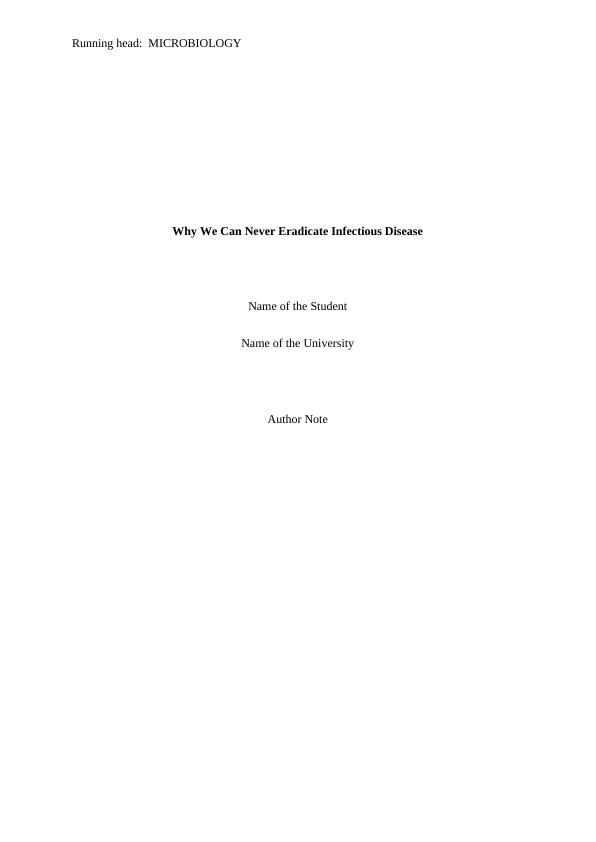
MICROBIOLOGY
Introduction
Infectious disease arising out of bacteria can be transmitted from animals to people
and from one person to another person. These infections can be mild to severe and can
eventually lead to the development of serious illness that if left out may lead to life
threatening diseases (Nelson and Williams 2013). According to the reports published by the
Parliamentary Office of Science and Technology in UK (2017), infectious diseases cause
significant economic and health burden in UK which accounts to about 7% of death and with
an annual cost of £30bn. However, even under the presence of broad spectrum and third or
fourth generation antibiotics and presence of advanced quality molecular detection
technology, the overall eradication of the microbial diseases in UK and both globally is not
very promising. The following essay is mainly based on argument that why there is a
difficulty in eradicating the infections and life threatening diseases from UK or rather says
globally. In doing so, the essay will mainly explore the mechanism of bacterial adherence
and colonization within the host cell via the use of cell adhesion molecule, fimbriae or Pilli.
The essay also aims to throw light on the effects of bacterial toxins in disease propagation
and difficulty in prevention. In order to critically analyse the opinion and come to a
conclusion, the essay will also discuss the importance of antibiotics and is relation to disease
prevention and subsequent generation of multi-drug resistance gene (MDR) along with the
overall concept of biofilm production and its barrier towards antibiotics. The essay will also
discuss the role of microflora and its effect on immune-compromised people and roots behind
spread of infection. At the end essay will try to recommend the possible ways that are
showing promising results in the eradication of the bacterial infections.
Introduction
Infectious disease arising out of bacteria can be transmitted from animals to people
and from one person to another person. These infections can be mild to severe and can
eventually lead to the development of serious illness that if left out may lead to life
threatening diseases (Nelson and Williams 2013). According to the reports published by the
Parliamentary Office of Science and Technology in UK (2017), infectious diseases cause
significant economic and health burden in UK which accounts to about 7% of death and with
an annual cost of £30bn. However, even under the presence of broad spectrum and third or
fourth generation antibiotics and presence of advanced quality molecular detection
technology, the overall eradication of the microbial diseases in UK and both globally is not
very promising. The following essay is mainly based on argument that why there is a
difficulty in eradicating the infections and life threatening diseases from UK or rather says
globally. In doing so, the essay will mainly explore the mechanism of bacterial adherence
and colonization within the host cell via the use of cell adhesion molecule, fimbriae or Pilli.
The essay also aims to throw light on the effects of bacterial toxins in disease propagation
and difficulty in prevention. In order to critically analyse the opinion and come to a
conclusion, the essay will also discuss the importance of antibiotics and is relation to disease
prevention and subsequent generation of multi-drug resistance gene (MDR) along with the
overall concept of biofilm production and its barrier towards antibiotics. The essay will also
discuss the role of microflora and its effect on immune-compromised people and roots behind
spread of infection. At the end essay will try to recommend the possible ways that are
showing promising results in the eradication of the bacterial infections.
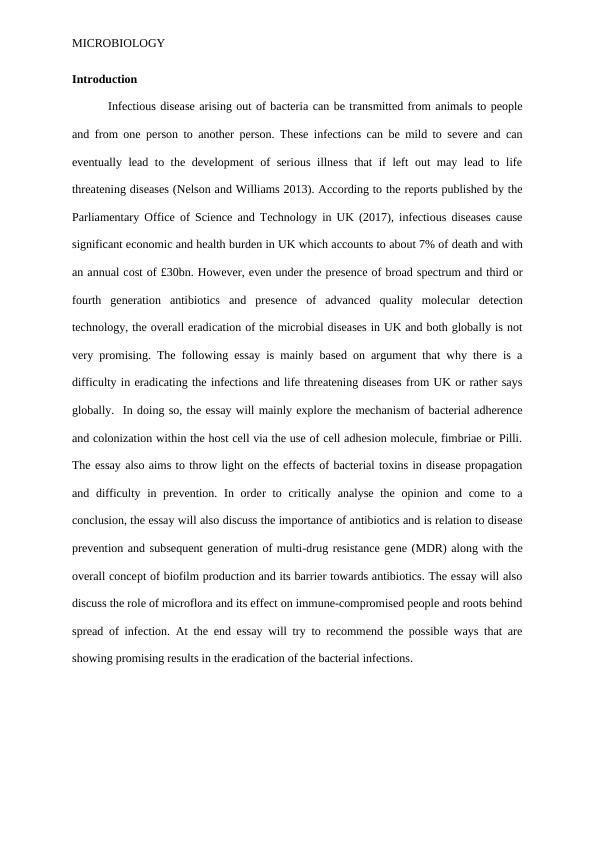
MICROBIOLOGY
The virulent factors
The capability of the bacteria to cause disease reflects the relative pathogenicity.
Virulence is the measure of the pathogenicity of the virus. The degree of the virulence is
linked to the ability of the organism for causing diseases in spite of the host resistance
mechanism of the body. The factors that are produced by the microorganism and disease are
called the virulence factors, such as the toxins and the surface coats that inhibit the
phagocytosis and the surface receptors binding to the host cells.
In order to cause infection, the bacteria should adhere to the mucosal surface. For
example, the mucosa of the alimentary tract is repeatedly cleaned by the mucus secreted by
the goblet cells and by the peristaltic movement of the gut content over the epithelium. In
order to establish infection in such a site, the bacteria have to adhere to the mucosal surface.
For accomplishing this, bacteria have evolved certain mechanism such as fimbriae that
recognize and help in attachment of the bacteria (Haiko and Westerlund-Wikström 2013).
The colonization factors of the bacteria play an important role in the pathogenic mechanism
of the bacteria.
The external surface of bacteria acts as the central interface between the pathogen and
the host and recognition of the exposed surface by the immune system provided by the host a
key sign for the microbial clearance (Haiko and Westerlund-Wikström 2013). A study by
Olsen et al. (2013) have shown that the flagellum of a bacteria influences the virulence by
facilitating movement. There are early studies that have shown that the single polar flagellum
of Vibrio cholera is crucial for its virulence. Again V. Cholera that is not motile cannot
induced virulence. Recently, Olsen and colleagues have proved the involvement of the
serovar specific differences of the chemotaxis genes and flagella in the adhesion of the
Salmonella. It also provides the pathogen to mimic the immune modulators of the host, in
order to modify the immune responses of the host or to express receptor ligands or adhesions
The virulent factors
The capability of the bacteria to cause disease reflects the relative pathogenicity.
Virulence is the measure of the pathogenicity of the virus. The degree of the virulence is
linked to the ability of the organism for causing diseases in spite of the host resistance
mechanism of the body. The factors that are produced by the microorganism and disease are
called the virulence factors, such as the toxins and the surface coats that inhibit the
phagocytosis and the surface receptors binding to the host cells.
In order to cause infection, the bacteria should adhere to the mucosal surface. For
example, the mucosa of the alimentary tract is repeatedly cleaned by the mucus secreted by
the goblet cells and by the peristaltic movement of the gut content over the epithelium. In
order to establish infection in such a site, the bacteria have to adhere to the mucosal surface.
For accomplishing this, bacteria have evolved certain mechanism such as fimbriae that
recognize and help in attachment of the bacteria (Haiko and Westerlund-Wikström 2013).
The colonization factors of the bacteria play an important role in the pathogenic mechanism
of the bacteria.
The external surface of bacteria acts as the central interface between the pathogen and
the host and recognition of the exposed surface by the immune system provided by the host a
key sign for the microbial clearance (Haiko and Westerlund-Wikström 2013). A study by
Olsen et al. (2013) have shown that the flagellum of a bacteria influences the virulence by
facilitating movement. There are early studies that have shown that the single polar flagellum
of Vibrio cholera is crucial for its virulence. Again V. Cholera that is not motile cannot
induced virulence. Recently, Olsen and colleagues have proved the involvement of the
serovar specific differences of the chemotaxis genes and flagella in the adhesion of the
Salmonella. It also provides the pathogen to mimic the immune modulators of the host, in
order to modify the immune responses of the host or to express receptor ligands or adhesions
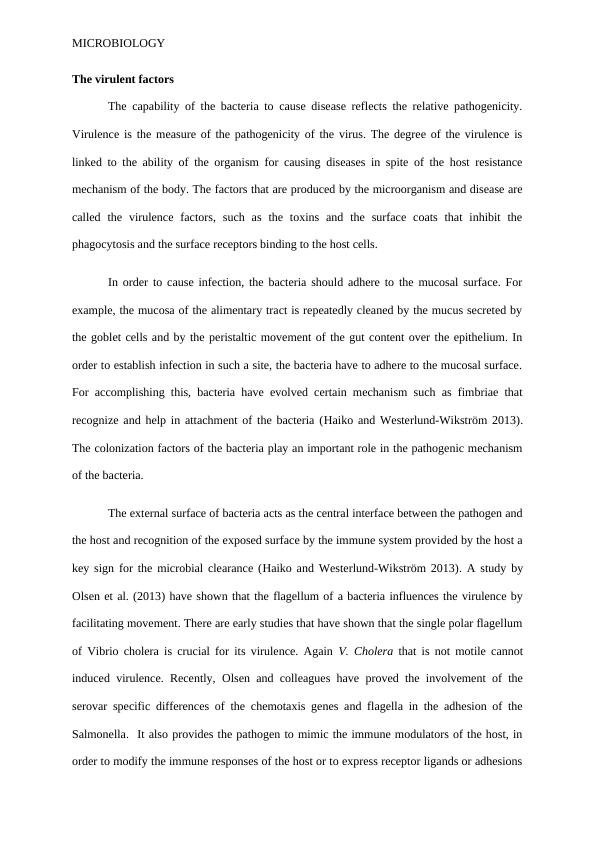
MICROBIOLOGY
for anchoring to the host surfaces (Haiko and Westerlund-Wikström 2013). Supporting this
findings, Girón and colleagues that some of the wild type strains of E. Coli expressing the H2
or H6 flagella can adhere and form micro-colonies to the HeLa cells.
Other surface molecules like the protective capsules can increase the survival of the
pathogen within the host (Willey et al. 2008). A common mechanism to mask the complex
antigenic surface from spotting by the immune surveillance is the expression of a
carbohydrate capsule. For example Streptococcus pneumonia, uses its capsule to prevent the
deposition of the complement and antibody on its surface, thereby preventing clearance by
phagocytosis or opsonisation (Finlay and McFadden 2006). The lipid A component of the
Lipopolysaccharide (LPS), present in the Gram negative bacteria, plays a crucial role in the
activation of the TLR. However the outer part of the LPS consists of variable forms of
carbohydrates providing each of the strain with their unique serotype (O antigen). Thus
different strains can infect the same host due to different surface antigens (Finlay and
McFadden 2006). There are certain gram negative bacteria that alter the lipid A for altering
the TLR4 response. For Example, There are two component sensors present in Salmonella;
(PhoP/PhoQ) that can sense the host environment regulating many genes. Modification of the
lipid A makes it much less active for TLR4 activation (Prescott and Harley 1994).
The bacterial pathogens have developed special secretion system for exporting the
virulence factors across the bacterial membranes. Virulence factors such as the toxins or the
immune modulators are secreted in to the host cells. Both the type III secretion systems
(T3SS) and type IV secretion systems (T4SS), can introduce, various virulence factors in to the
host cells. These two types of secretion system possess very diverse repertoire of the effector
molecules that can be delivered in to the host cells, paralyzing the phagocytosis and altering
other immune functions (Finlay and McFadden 2006). Although the structures of the gram
positive bacteria are much simpler, they can also generate specialized pores for delivering the
for anchoring to the host surfaces (Haiko and Westerlund-Wikström 2013). Supporting this
findings, Girón and colleagues that some of the wild type strains of E. Coli expressing the H2
or H6 flagella can adhere and form micro-colonies to the HeLa cells.
Other surface molecules like the protective capsules can increase the survival of the
pathogen within the host (Willey et al. 2008). A common mechanism to mask the complex
antigenic surface from spotting by the immune surveillance is the expression of a
carbohydrate capsule. For example Streptococcus pneumonia, uses its capsule to prevent the
deposition of the complement and antibody on its surface, thereby preventing clearance by
phagocytosis or opsonisation (Finlay and McFadden 2006). The lipid A component of the
Lipopolysaccharide (LPS), present in the Gram negative bacteria, plays a crucial role in the
activation of the TLR. However the outer part of the LPS consists of variable forms of
carbohydrates providing each of the strain with their unique serotype (O antigen). Thus
different strains can infect the same host due to different surface antigens (Finlay and
McFadden 2006). There are certain gram negative bacteria that alter the lipid A for altering
the TLR4 response. For Example, There are two component sensors present in Salmonella;
(PhoP/PhoQ) that can sense the host environment regulating many genes. Modification of the
lipid A makes it much less active for TLR4 activation (Prescott and Harley 1994).
The bacterial pathogens have developed special secretion system for exporting the
virulence factors across the bacterial membranes. Virulence factors such as the toxins or the
immune modulators are secreted in to the host cells. Both the type III secretion systems
(T3SS) and type IV secretion systems (T4SS), can introduce, various virulence factors in to the
host cells. These two types of secretion system possess very diverse repertoire of the effector
molecules that can be delivered in to the host cells, paralyzing the phagocytosis and altering
other immune functions (Finlay and McFadden 2006). Although the structures of the gram
positive bacteria are much simpler, they can also generate specialized pores for delivering the
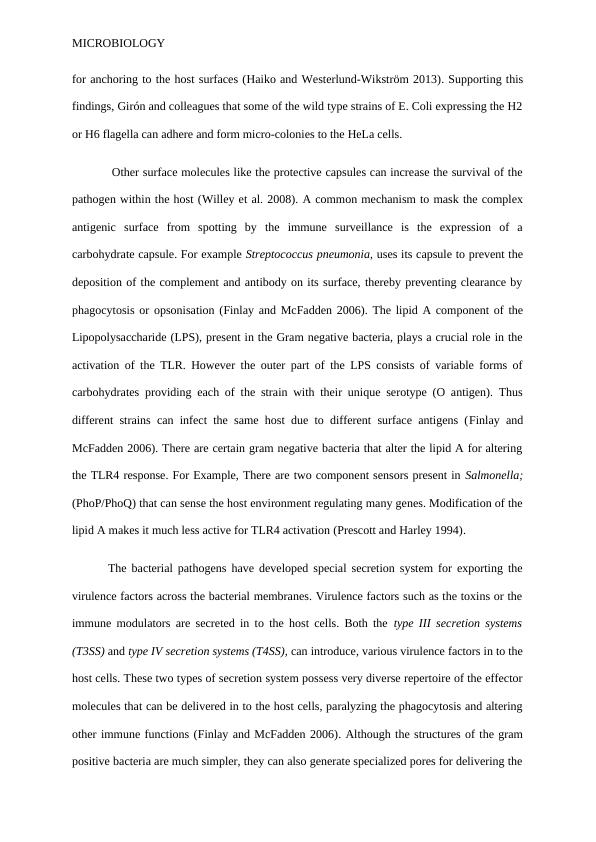
MICROBIOLOGY
bacterial molecules. Furthermore antigenic variation in the bacteria is also the main reason
why bacterial invasion cannot be prevented. The mechanism usually follows one of the three
mechanisms 1) bearing multiple copies of the molecules, each having an independent on/off
switch. 2) Possessing one expression locus with many silent copies of the gene and constant
modification of the expressed genes 3) Presence of a highly variable region that keeps on
changing. For example the Neisseria species contains 10-11 outer membrane Opa proteins,
which are antigenically different from each other and hence can switch the terminal sugar
structures.
Anti-immune strategies for the bacteria
Strategy Bacterial example
Surface modulators - Lipid A of LPS, capsules, adhesions,
invasions (Duan et al. 2013).
Antigenic hypervariability - pili, outer membrane proteins, LPS,
variation from one strain to the other.
Killing of the immune cells/phagocytes Super antigens, - blocking the inflammatory
pathways by the injection of the effectors.
Inhibit complement Production of capsules and long chain LPS
for avoiding complement deposition and
attack of MAC.
Interfere with TLRs Alteration of the TLR ligands to lessen
recognition.
Hide from immune surveillance Avoiding phago-lysosomal fusion and
inhibiting phagocytosis.
bacterial molecules. Furthermore antigenic variation in the bacteria is also the main reason
why bacterial invasion cannot be prevented. The mechanism usually follows one of the three
mechanisms 1) bearing multiple copies of the molecules, each having an independent on/off
switch. 2) Possessing one expression locus with many silent copies of the gene and constant
modification of the expressed genes 3) Presence of a highly variable region that keeps on
changing. For example the Neisseria species contains 10-11 outer membrane Opa proteins,
which are antigenically different from each other and hence can switch the terminal sugar
structures.
Anti-immune strategies for the bacteria
Strategy Bacterial example
Surface modulators - Lipid A of LPS, capsules, adhesions,
invasions (Duan et al. 2013).
Antigenic hypervariability - pili, outer membrane proteins, LPS,
variation from one strain to the other.
Killing of the immune cells/phagocytes Super antigens, - blocking the inflammatory
pathways by the injection of the effectors.
Inhibit complement Production of capsules and long chain LPS
for avoiding complement deposition and
attack of MAC.
Interfere with TLRs Alteration of the TLR ligands to lessen
recognition.
Hide from immune surveillance Avoiding phago-lysosomal fusion and
inhibiting phagocytosis.
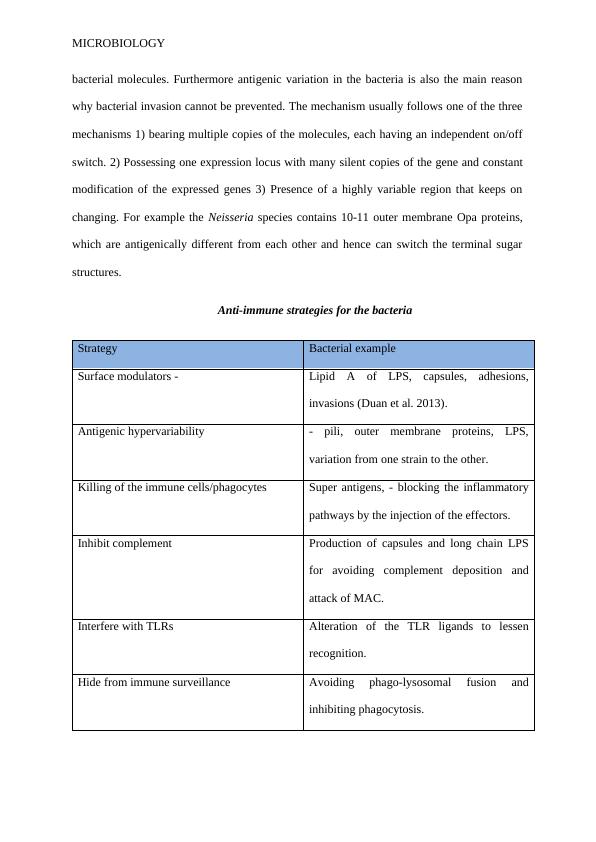
MICROBIOLOGY
Bio-films and its relation to spread of infection
Bio-films and the spread of nocosomial infection
Multidrug-resistant (MDR) organisms like Methicillin-resistant Staphylococcus
aureus (MRSA), Acinetobacter baumanni and extended spectrum beta lactum producing
gram-negative bacteria are frequently highlighted as the main causative agent behind the
acute and chronic infectious diseases which lead to the generation of significant mortality and
morbidity along with overall increase in the health care cost (McGrath and Asmar 2011). Till
date various studies have indicated that the human infections are mainly caused by the ability
of the bacteria to develop surface attached polymicrobial communities which are popularly
known as biofilms (Sánchez et al. 2013). According to Flemming et al. (2016), microbial
biofilms are made of a groups of bacterial cells which are adherent to the surface and are
enclosed with in a self-produced extracellular matrix. Adaptation to the surface attached
growth within a biofilm is accompanied via a significant change in the protein and gene
expression along with the overall microbial activity. Numerous pathogenic and nosocomial
bacteria have been observed to exist predominantly as biofilms under both natural
environment and under infected tissues as polymicrobial communities. Notably, the
formation of biofilms is implicated as one of the significant factors behind the increased
number of the chronic bacterial infections (Sánchez et al. 2013).
The randomised control trial (RCT) conducted by Sánchez et al. (2013) from the
clinical isolated of the patients suffering from bacterial infection, highlighted that the
formation of biofilms increases the tendency of recurrent bacterial infection. Their RCT
showed that MDR pathogens are more prone towards the formation of biofilms and the
strains from the patients with persistent bacterial infection generated positive results in
biofilm formation. The systematic review conducted by Bjarnsholt (2013) showed that the
biofilm infections like the pneumonia in cystic fibrosis patients, chronic otitis media, chronic
Bio-films and its relation to spread of infection
Bio-films and the spread of nocosomial infection
Multidrug-resistant (MDR) organisms like Methicillin-resistant Staphylococcus
aureus (MRSA), Acinetobacter baumanni and extended spectrum beta lactum producing
gram-negative bacteria are frequently highlighted as the main causative agent behind the
acute and chronic infectious diseases which lead to the generation of significant mortality and
morbidity along with overall increase in the health care cost (McGrath and Asmar 2011). Till
date various studies have indicated that the human infections are mainly caused by the ability
of the bacteria to develop surface attached polymicrobial communities which are popularly
known as biofilms (Sánchez et al. 2013). According to Flemming et al. (2016), microbial
biofilms are made of a groups of bacterial cells which are adherent to the surface and are
enclosed with in a self-produced extracellular matrix. Adaptation to the surface attached
growth within a biofilm is accompanied via a significant change in the protein and gene
expression along with the overall microbial activity. Numerous pathogenic and nosocomial
bacteria have been observed to exist predominantly as biofilms under both natural
environment and under infected tissues as polymicrobial communities. Notably, the
formation of biofilms is implicated as one of the significant factors behind the increased
number of the chronic bacterial infections (Sánchez et al. 2013).
The randomised control trial (RCT) conducted by Sánchez et al. (2013) from the
clinical isolated of the patients suffering from bacterial infection, highlighted that the
formation of biofilms increases the tendency of recurrent bacterial infection. Their RCT
showed that MDR pathogens are more prone towards the formation of biofilms and the
strains from the patients with persistent bacterial infection generated positive results in
biofilm formation. The systematic review conducted by Bjarnsholt (2013) showed that the
biofilm infections like the pneumonia in cystic fibrosis patients, chronic otitis media, chronic
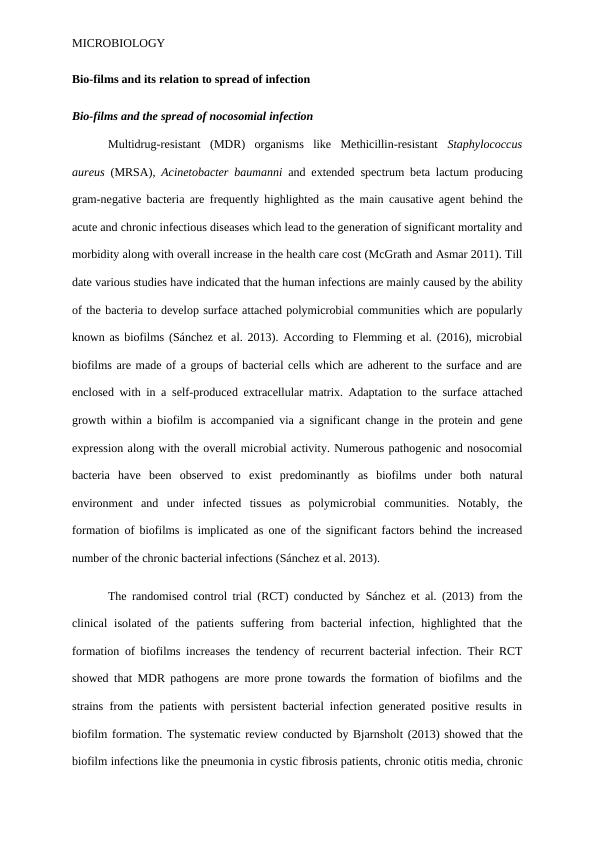
End of preview
Want to access all the pages? Upload your documents or become a member.
Related Documents
What is a review article? | Assignmentlg...
|23
|22834
|10
Pathogenicity In Escherichia colilg...
|11
|2692
|14
Bacteroid fragilis: Clinical Manifestations, Structure, Pathogenesis, Diagnosis, Treatment and Preventionlg...
|6
|1218
|370
The Rise in Antibiotic Resistant Bacteria: A Threat to Efficacy of Antibioticslg...
|4
|792
|357
Invasion Of Pathogenic Escherichialg...
|12
|6941
|14
Microorganisms, Vector-borne Diseases, and Infection Preventionlg...
|11
|4269
|432
